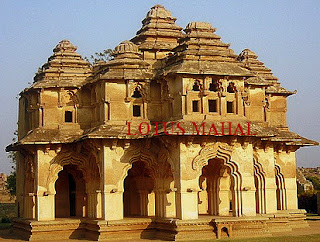Once the majestic capital of the powerful Vijayanagara Empire, Hampi is now a ruined city of ancient palaces and forts. Founded by Harihara and Bukka in 1336, the landscape of Hampi was dotted with magnificent palaces, sacred temples, massive fortifications, baths, markets, pavilions, and stables for royal elephants. The Vijayanagara kings were great patrons of art and Hampi became the epicenter of a flourishing indigenous culture.
All of these were gradually reduced to rubble as the Empire fell to the Muslim invaders of North India in 1565 after the disastrous Battle of Talikota. The victors mercilessly pillaged this capital city and the ruins were left to tell the tale of the bygone era. Now declared a World Heritage Site by UNESCO, tourists and enthusiastic backpackers travel to Hampi in large numbers.
The sprawling city was planned in such a way that the important structures are located in two areas, referred to as the Royal Centre and the Sacred Centre. The Royal Centre contains remnants of opulent palaces, baths, pavilions, royal stables, while the Sacred Centre locates holy temples. The Sacred Centre is situated on the northern edge of the city along the banks of the holy Tungabhadra River.
Places to See:
Virupaksha Temple
The majestic Virupaksha temple stands proudly amidst the ruins of Hampi. While the city of Hampi was pillaged by marauding invaders, the Virupaksha temple stood erect and worship continued throughout the ages. The deity of Virupaksheshwara or Pampapathi, an incarnation of Lord Shiva, is worshipped here.
King's Balance
King's balance is a unique spot among the tours to Hampi. The King's Balance consists of two lofty carved granite pillars about 15 feet high supporting a stone beam about 12 feet, provided with three hoops on the underside. Also known as Tula Bhara or Tula Purushadana, the balance was used to weigh the kings of Vijayanagara on certain occasions like solar or lunar eclipse, New years day and coronation day against precious diamonds, gems, gold, silver, etc. and distribute them to the Brahmins.
Lotus Mahal
A synthesis of the Hindu and Muslim styles of architecture. High on aesthetics, this elegant structure has two levels, with open pavilions at the bottom and balconies above. Lotus Mahal derives its name from its beautiful, geometrically arranged cusped arches that resemble the petals of a flower opening to the sun.
Vithala Temple
Located on the southern banks of the Tungabhadra River, the Vithala temple is another imposing structure amidst the ruins. The large Ranga Mantapa of the temple has 56 musical pillars that resound with musical notes when struck. In the temple courtyard stands a magnificent stone chariot, so perfectly proportioned that the stone wheels actually rotate.
http://famousindiantouristplaces.blogspot.com





No comments:
Post a Comment